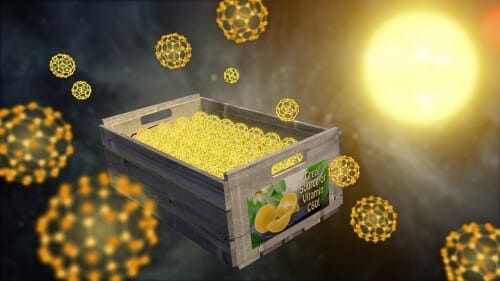The existing findings suggest that buckyballs are even more common in space than previously thought

Astronomers who used data from NASA's Spitzer Space Telescope discovered, for the first time ever, buckyballs in a solid state in space. Until this discovery, the microscopic carbon balls were found in the universe only in their gaseous form.
Under their former name - Buckminster Fullerne, buckyballs are named after their resemblance to the architect Buckminster Fuller's geodesic domes. They consist of sixty carbon atoms organized into a hollow ball, similar to a football. Their unique structures make them ideal candidates for electronic and chemical applications on Earth, including superconducting materials, medical materials, water treatment, and armor.
In their previous discovery, scientists using the Spitzer telescope detected tiny blobs of matter, or particles, made up of stacked buckeye balls. They located the particles around a pair of stars called "XX Ophiuchi" at a distance of 6500 light years from the Earth, and discovered an amount that would be enough to fill 10000 mountains such as Everest.
"These buckeye balls are clumped together to form a solid, similar to a bunch of oranges in a box," said researcher Nye Evans of Keele University in England, lead author of a paper describing the findings. "The particles we found are tiny, much smaller than the thickness of her hair, but each of them may contain stacks of millions of Buckyballs."
Bucky balls were first discovered in space with certainty by the Spitzer telescope in 2010. The same telescope has located these molecules in many different cosmic environments. He even managed to locate them in incredible quantities, equivalent in value to the mass of 15 Earth's moons, in a nearby galaxy called the Small Magellanic Cloud (SMC-Small Magellanic Cloud).
In all these cases the molecules were in a gaseous state. The current discovery of Buckeye ball particles means that large amounts of these molecules must be present in stellar environments for them to bind together to form solid particles. The research team was able to identify the solid form of the Buckeye balls in the data from the Spitzer telescope because they emit a unique radiation that distinguishes them from their gaseous form.
"The existing findings suggest that buckyballs are even more common in space than previous data from the Spitzer telescope showed," said one of the study's scientists. "They may be an important form of carbon, an essential building block for the creation of life, throughout the entire universe."
Buckeye balls have been found on Earth in various forms. They appear in their gaseous form following the burning of candles and exist in solid form in various types of rocks, such as the mineral shungite found in Russia, and the mineral fulgurite, a glassy rock found in Colorado that is obtained when lightning strikes the ground. In a laboratory test, the solid appears as a dark brown sticky substance.

5 תגובות
"Until this discovery, the microscopic carbon balls were found in the universe only in their gaseous form." Does that mean the observation changed the state of matter in the universe?
The dew of the cosmos
The solid does come dark brown sticky material! 🙂
To the point, a bit surprising, but maybe it's natural for carbon to collect into bucky balls.